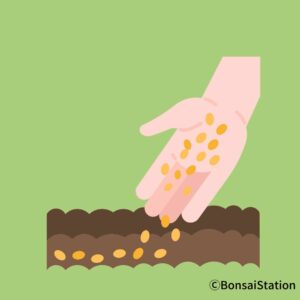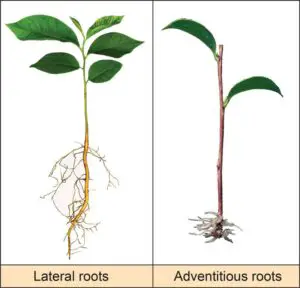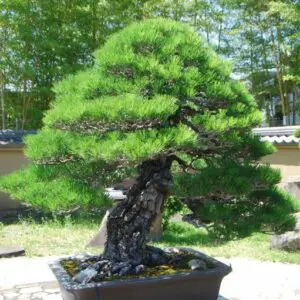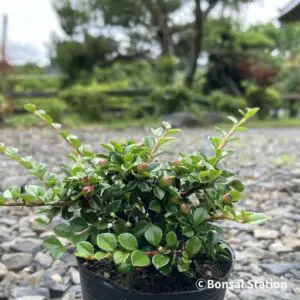Is it better to grow bonsai from seed or cuttings?
Definition of propagation by seed and by cuttings
Propagation by seed

Seed germination is a simple process where seeds are sowed, then they germinate, develop and grow into new plants.
Propagation by cuttings
A cutting is a method of plant propagation using a section of a plant that forms adventitious roots (or shoots).
Adventitious roots are those arising from an organ other than the root (called lateral roots), such as a stem or a leaf. Although adventitious and lateral roots function the same, lateral roots grow straight down into the soil whereas adventitious roots grow horizontally to the ground.

Lateral and adventitious roots
(Source: University of Florida)
There are 3 types of cuttings: stem, leaf and root, all of which are used in bonsai propagation.
Stem cuttings
Stem cutting uses a piece of a plant stem or branch including at least one node, usually a few. This is the most popular technique among cuttings and works for most tree species that can be propagated by cuttings.
Leaf cuttings
Leaf cutting uses a leaf or a leaf with a petiole. This leaf will generate not only new roots but also new shoots. Hinoki cypress, Chinese juniper and camellia are among the bonsai species good for leaf cuttings.
Root cuttings
Root cutting uses sections of roots. Only a few bonsai species, such as mulberry, wisteria and bamboo, can be propagated by root cuttings. With root cuttings, each root produces two to three new stems and each stem then produces its own roots. The original root cutting disintegrates after that.
Pros and cons of growing bonsai from seeds
Pros of growing from seeds

Some of the reasons you should grow your bonsai from seed are;
- you can grow in a large amount,
- you can style the tree to your liking, and
- it is good for mini bonsai.
Can grow in a large amount
Generally, it is much easier to prepare seeds in large amounts than cuttings if you can collect them yourself. You are then able to start more new trees, which is better because some of them will die while growing.
Can style to your liking
You can style the tree perfectly to your liking and have good surface roots, which sometimes is difficult when you start training a tree half-grown. The trees grown from seeds have the potential to be exquisite bonsai trees.
Good for mini bonsai
Growing from seed is a good way to have mini bonsai. Mini bonsai is the smallest bonsai by size classification with a size roughly below 8 inches (20cm) tall. Because mini bonsai trees are tiny even as bonsai, it is especially important to have good ramifications with lots of fine branches and short internodes, which are easier to style when you grow from seedlings.
Cons of growing from seeds

The disadvantages of growing bonsai from seeds are;
- you do not know if the parent tree is good bonsai,
- seedlings will not be identical to the parent tree, and
- some seeds are difficult to germinate.
Unknown parent tree
You do not know whether the parent tree has characteristics you want for your bonsai tree or not unless you collect the seeds yourself. It is important to choose a good parent tree fit for bonsai because the bonsai trees are ordinary trees that grow to normal size if it is planted in the ground.
Not identical to the parent tree
Trees grown from seed will not be true to the parent; they will be different from them and from each other because they inherit the genetic properties of both parents, bringing genetic diversity that we do not want here.
Difficult to germinate
In order for seeds to grow, they must break dormancy and germinate, and some seeds need painstaking processes to break the dormancy. You may need to file/scratch with sandpaper or boil them in hot water to break the seed coat, or chill them in the fridge for some time before sowing. Or some seeds are just difficult to germinate, taking 2-3 years for the seedlings to appear.
Pros and cons of growing bonsai from cuttings
Pros of growing from cuttings

Some of the reasons you should grow your bonsai from cuttings are;
- new trees are clones,
- you can avoid the difficulties of germinating seeds,
- new trees mature faster,
- roots grow horizontally, and
- it is a simple process.
It is a clone
New trees grown from cuttings will be identical to the parent bonsai tree. If you choose a parent tree with dense foliage, smaller leaves, good ramification and beautiful bark, you can all have those characteristics in your new bonsai trees as well.
Can avoid difficulties of germinating seeds
Growing from cuttings is a fairly easy process and does not need painstaking steps needed for the germination of some species.
Will mature faster
For reasons yet fully known, a new tree grown from a cutting will frequently mature faster than a tree grown from seed. They have a shorter juvenile phase, leading to bearing flowers and fruits at an early age.
Roots grow horizontally
Adventitious roots that grow from cuttings grow horizontally to the soil, unlike ordinary roots that grow straight down. This is preferable for bonsai trees because bonsai pots are shallow and they need good surface roots that grow in every direction.
Simple process
Propagation by cuttings is an easy and simple process as well as free if you already have a parent tree.
Cons of growing from cuttings

The disadvantages of growing bonsai from cuttings are;
- it may be difficult to have enough cuttings,
- the process is not for all species,
- only younger trees can be used as a source,
- there is a risk of uneven rooting, and
- new trees can be dead at once.
Difficult to have enough cuttings
It may be difficult to prepare enough cuttings good to be planted. There are some criteria that cuttings should meet to be adequate for propagation; the stem or leaf to be robust or only the tips of a branch or dormant roots can be used.
Depending on how many parent trees you can use, the number of adequate cuttings can be limited.
Not for all species
Due to their genetic characteristics, some tree species have difficulties propagating from cuttings. Pinus species, such as Japanese red/black/white pine, fir, hemlock and norway spruce are some of the known bonsai species that are not fit for cuttings. They can be propagated by seeds way easier than cuttings.
Only younger trees can be used
In general, cuttings taken from young trees root much easier than cuttings taken from older, more mature ones. The rooting ability of trees is closely related to the youth of the plant body, and the younger the tree, the higher the rooting ability. As tree ages, the percentage of rooting becomes significantly lower even for the species that are good for cuttings.
Uneven rooting
Some of the new trees’ rooting formations can be uneven, meaning roots come out from only one side and not evenly around the cuttings. This uneven rooting is caused by several factors including the tree genotype, the developmental stage of the cutting, environmental influences, impaired vitality of cuttings and insufficient root formation.
This is not only desirable for the nurturing of good surface roots (“nebari”) but also for symmetric growth of the branches since the growth of the soil above reflects that of the below.
Possibility of dying at once
Because the new trees are clones, they may all die off from a single disease/pest or change in the environment. Genetic diversity enables trees to respond more effectively to adverse conditions. Some are more resistant to parasites or pathogens than others, limiting the risk of their prevalence. Or some are more cold-/ heat-resistant than others.
Seedling plants have greater tolerance to adverse soil and climatic conditions and diseases.
What is the easiest bonsai tree to grow from seed?

Japanese black pine
Pinus species, such as Japanese red/black/white pine, is the easiest bonsai tree to grow from seed.
Seeds from pinus species can be stored at room temperature in a box, unlike other species which need to be stored in a humid place or in the fridge. They just need to be soaked in water overnight before being sowed. Also, pinus seeds are quite strong and the germination rate does not fall significantly for 2 to 3 years after gathering seeds.
It is in fact very difficult (not impossible though) to grow pinus species from cuttings, so if you are interested in growing pinus tree bonsai from a very early stage, growing from seed is the way.
Japanese maple, azalea and camellia are also among the easy bonsai to grow from seed, though they need special storage.
What is the easiest bonsai tree to grow from cuttings?

Cotoneaster bonsai in training
The easiest bonsai tree to grow from cuttings is cotoneaster horizontalis bonsai.
Cotoneaster horizontalis is flowering/fruiting/deciduous bonsai species native to Asia, Europe and North America. It prefers a sunny to half-shady location and tolerates drought very well.
Cuttings should be taken from the previous year’s or current season’s branches with 4 to 6 nodes from May to June. Put them in lava rocks or Akadama of small grains and water them when the soil is half dry. You do not need to sterilize or put root growth hormone.
From my experience, most of the cotoneaster cuttings will take root after 4 to 6 weeks. Even beginners can propagate easily.
Besides cotoneaster, azalea and Japanese cedar (cupressus japonica) are among the bonsai species that are easy to propagate by cuttings.




